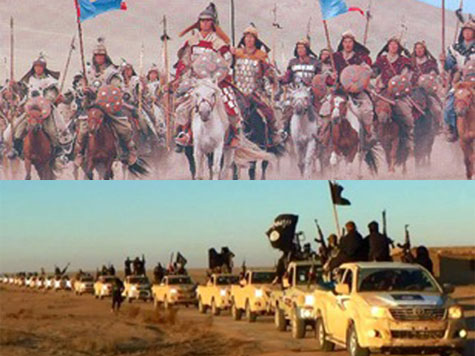While the use of air power is a tempting alternative to “boots on the ground” and appears to be the emerging strategy, ISIS is actively developing its own tactics and strategy to mitigate the effectiveness of air strikes against ISIS assets and leadership while building a state-like entity across a border that now only exists in dated textbooks and Western minds.
The following is a primer on ISIS operational doctrine as it has played out over the last few weeks in Iraq.
Like their Mongol predecessors who sacked Baghdad in 1258, ISIS begins its invasions by sending envoys to towns and population centers just hours prior to the arrival of actual forces. Within this window, local defense forces lack the time to organize resistance, often retreating in fear of an Islamist advance. ISIS shura leaders have successfully convinced several military and local leaders to resign and flee, occasionally even stripping off their uniforms in the streets. This leverages ISIS’ numeric inferiority – Islamists gain ground by terror and threat of carnage, not a mere coefficient of forces.
Police and other municipal buildings are ISIS’ first targets upon entering a city. Police offices have been immediately looted for weapons and torched, with prisoners released and conscripted into ISIS. ISIS has more than recouped its casualties, having added thousands of prisoners to their ranks, with the greatest number being added in Mosul. Secondly, control of core infrastructure, such as water and electricity, enables militants to completely control the remaining populace access to vital needs, as well as the ability to cut off and starve parts of the city into submission.
Third, remaining military resistance and civil leadership has been isolated and targeted with suicide bombers. Reports indicate as many as six suicide bombers are being sent against a single target, though often the military surrenders after less. Leaders who will not kowtow – including those who worked alongside US troops during the Anbar Awakening that ousted Al Qaeda during the Iraq war – are being targeted by suicide bombers as a means of destroying rival authorities.
Upon establishing occupation ISIS spreads its forces out, avoiding centralized emplacements that might make an attractive target. Movement on tarmac is also structured to minimize the threat of aerial bombardment, with convoys limited to small numbers (reports indicate less than 60 is the informal rule). ISIS is reported to have roughly 1.4 billion USD in assets, and it shows; photos are emerging of convoys of brand new, matching white Toyota pickups following “sand people” rules through the desert, making ISIS’ equipment more uniform than that of the Iraqi military.
Speed and maneuverability characterize combat in a desert, and to this ISIS is no stranger. Recently in al-Anbar ISIS routed a border patrol convoy of 60 trucks and over 100 guardsmen with just 10 vehicles. In proper biblical style, only two guards survived, allowed to flee on foot through the desert.
Though ISIS is heavily composed of Syrians and other foreign fighters, it has begun to tap domestic Sunni organizations to hand over local control to. As Iraq expert Juan Cole has pointed out, ISIS is too small to hold ground and is incorporating local Sunni militants as additional cadres. Baathists under The Army of the Men of the Naqshabandi Order and the General Military Council of Iraqi Rebels are suspected of being the two primary militias that have sent their levies to ISIS.
Over the last 2 weeks more than 2,600 Iraqi civilians have been killed by ISIS, with 300,000 displaced. This comes on top of the already 250,000 Syrian refugees already present in Iraq. No amount of flying over a problem of this proportion will change it.

COMMENTS
Please let us know if you're having issues with commenting.